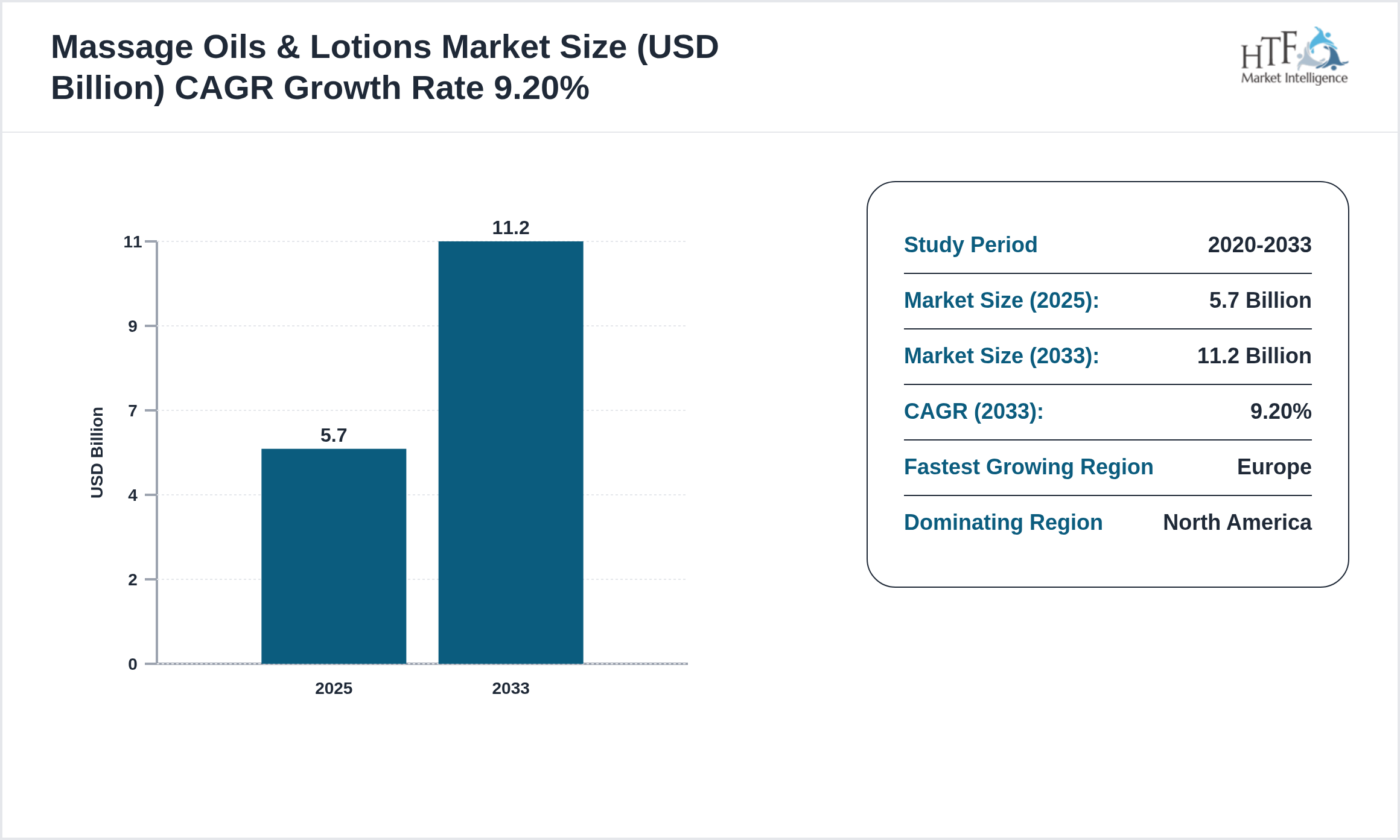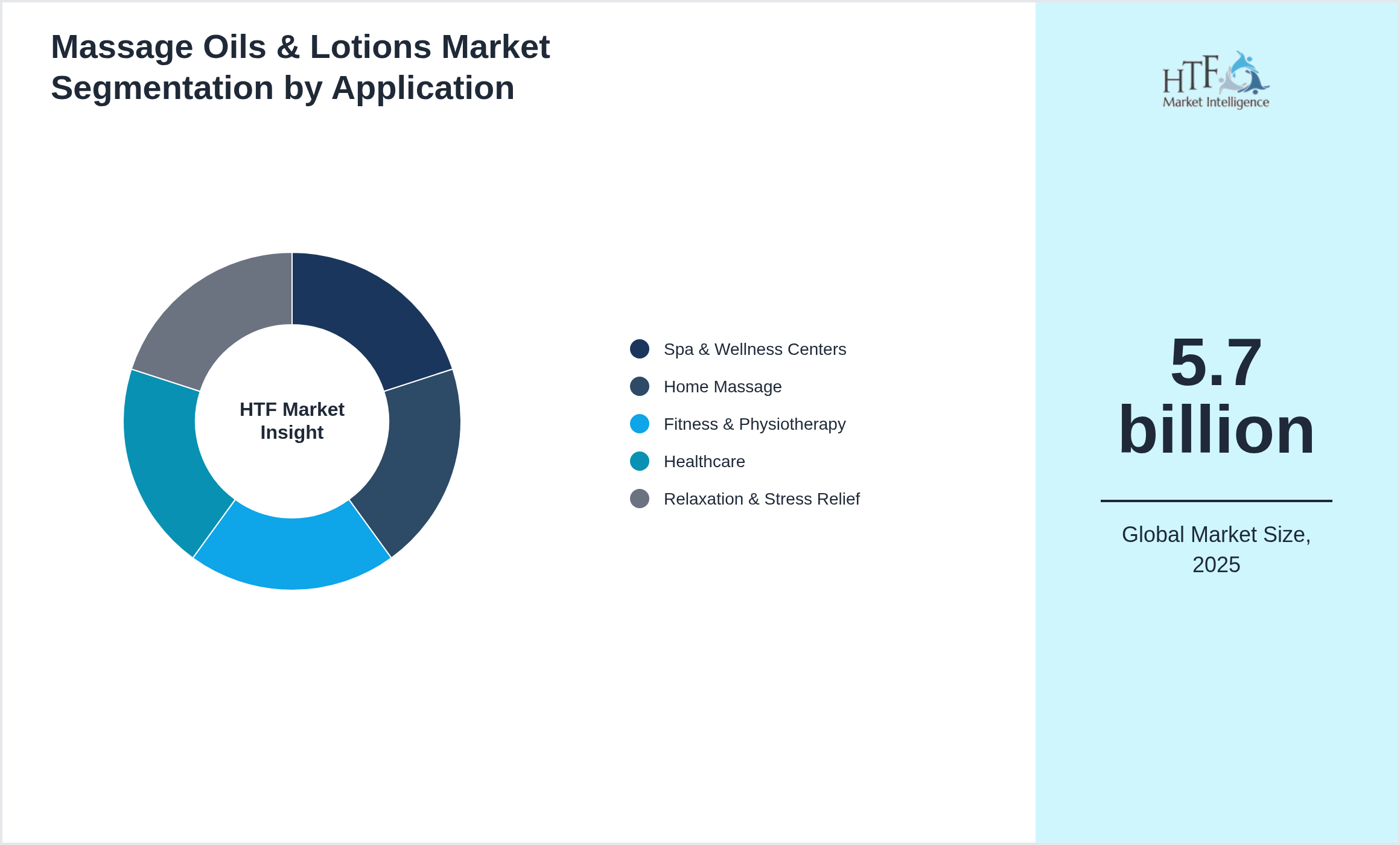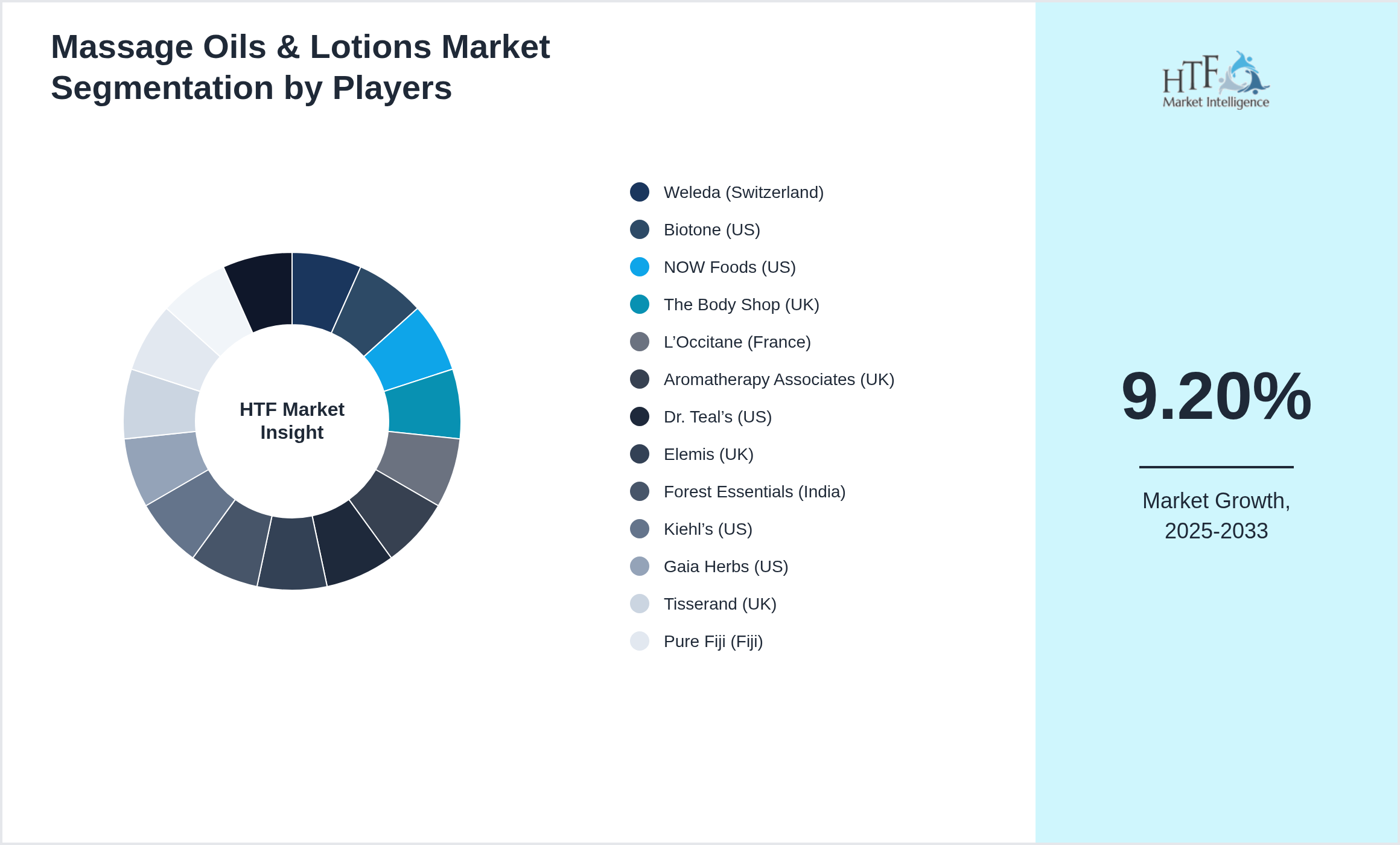Massage Oils & Lotions Market Research Report
Massage Oils & Lotions Market Rewriting Incredible Growth
Global Massage Oils & Lotions Market is segmented by Application (Spa & Wellness Centers, Home Massage, Fitness & Physiotherapy, Healthcare, Relaxation & Stress Relief), Type (Aromatherapy Massage Oils, Therapeutic Massage Oils, Relaxation Lotions, Sports Massage Oils, Spa Massage Oils), and Geography (North America, LATAM, West Europe, Central & Eastern Europe, Northern Europe, Southern Europe, East Asia, Southeast Asia, South Asia, Central Asia, Oceania, MEA)
Pricing
Industry Overview
The Massage Oils & Lotions market is experiencing robust growth, projected to achieve a compound annual growth rate CAGR of 9.20% during the forecast period. Valued at 5.7 billion, the market is expected to reach 11.2 billion by 2033, with a year-on-year growth rate of 8.00%

The massage oils & lotions market consists of products used for relaxation, therapeutic, and wellness purposes. This includes aromatherapy oils, therapeutic oils, and specialized massage lotions used in spas, wellness centers, physiotherapy clinics, and at home. Growth is driven by increasing health and wellness awareness, the popularity of spa treatments, and rising disposable incomes. Innovations in natural and organic formulations, blends for aromatherapy, and premium products are contributing to market expansion.
Data Collection Method
Data triangulation is a method used to analyze markets by gathering and comparing information from multiple sources or utilizing different research approaches to examine the same topic. This technique involves integrating data from various sources, such as surveys, interviews, and industry reports, or combining both qualitative and quantitative methods. By employing data triangulation, researchers can cross-verify information, reduce biases, and achieve a more accurate and comprehensive understanding of market dynamics.
Key Highlights of the Massage Oils & Lotions
• The Massage Oils & Lotions is growing at a CAGR of 9.20% during the forecasted period of 2025 to 2033
• Year on Year growth for the market is 8.00%
• North America dominated the market share of 5.7 billion in 2025
• Based on type, the market is bifurcated into Aromatherapy Massage Oils, Therapeutic Massage Oils, Relaxation Lotions, Sports Massage Oils, Spa Massage Oils segment dominated the market share during the forecasted period
Market Segmentation
Segmentation by Type
- • Aromatherapy Massage Oils
- • Therapeutic Massage Oils
- • Relaxation Lotions
- • Sports Massage Oils
- • Spa Massage Oils
{TYPE_DONUGHT_GRAPH}
Segmentation by Application
- • Spa & Wellness Centers
- • Home Massage
- • Fitness & Physiotherapy
- • Healthcare
- • Relaxation & Stress Relief

This report also splits the market by region
- North America
- LATAM
- West Europe
- Central & Eastern Europe
- Northern Europe
- Southern Europe
- East Asia
- Southeast Asia
- South Asia
- Central Asia
- Oceania
- MEA
Regional Insights
The Massage Oils & Lotions market exhibits significant regional variation, shaped by different economic conditions and consumer behaviors.
- North America: High disposable incomes and a robust e-commerce sector are driving demand for premium and convenient products.
- Europe: A fragmented market where Western Europe emphasizes luxury and organic products, while Eastern Europe experiences rapid growth.
- Asia-Pacific: Urbanization and a growing middle class drive demand for both high-tech and affordable products, positioning the region as a fast-growing market.
- Latin America: Economic fluctuations make affordability a key factor, with Brazil and Mexico leading the way in market expansion.
- Middle East & Africa: Luxury products are prominent in the Gulf States, while Sub-Saharan Africa sees gradual market growth, influenced by local preferences.
Currently,North America dominates the market due to high consumption, population growth, and sustained economic progress. Meanwhile, Europe is experiencing the fastest growth, driven by large-scale infrastructure investments, industrial development, and rising consumer demand.
Key Players
The companies highlighted in this profile were selected based on insights from primary experts and an evaluation of their market penetration, product offerings, and geographical reach:
- • Weleda (Switzerland)
- • Biotone (US)
- • NOW Foods (US)
- • The Body Shop (UK)
- • L’Occitane (France)
- • Aromatherapy Associates (UK)
- • Dr. Teal’s (US)
- • Elemis (UK)
- • Forest Essentials (India)
- • Kiehl’s (US)
- • Gaia Herbs (US)
- • Tisserand (UK)
- • Pure Fiji (Fiji)
- • St. John’s Apothecary (US)
- • Phytoceuticals (US)

Companies within the industry are increasingly concentrating on broadening their market presence through a variety of strategic initiatives. These include mergers and acquisitions, as well as green investments, particularly in underdeveloped regions. Such strategies are proving instrumental in enabling these companies to capture a larger share of the market. By consolidating resources and expanding their geographical footprint, they not only enhance their competitive edge but also contribute to sustainable development in emerging markets. This approach not only fosters growth but also aligns with global trends toward environmental responsibility and corporate sustainability.
Competitive Landscape
The competitive landscape is shaped by a mix of global leaders and regional players, with large companies like Weleda (Switzerland), Biotone (US), NOW Foods (US), The Body Shop (UK), L’Occitane (France), Aromatherapy Associates (UK), Dr. Teal’s (US), Elemis (UK), Forest Essentials (India), Kiehl’s (US), Gaia Herbs (US), Tisserand (UK), Pure Fiji (Fiji), St. John’s Apothecary (US), Phytoceuticals (US) dominating the market through their extensive resources, innovation, and established brand presence. However, emerging players are disrupting the market with niche products and innovative technologies, challenging the incumbents. Pricing strategies vary, with larger firms benefiting from economies of scale while smaller players offer value-added services or customization. Geographical reach is key, as global companies expand across regions, while regional firms focus on local markets. Strategic partnerships and mergers continue to reshape the landscape, and barriers to entry remain high due to capital requirements and regulatory hurdles.
Get the full report to explore critical industry dynamics.
Price Trend Analysis
Price trend analysis is the study of historical pricing data to identify patterns and predict future price movements. It provides businesses with insights into how prices for goods or services change over time due to factors like market demand, supply levels, economic conditions, and external influences such as inflation or raw material costs.
This analysis is critical for businesses as it helps in developing effective pricing strategies. By understanding pricing trends, companies can adjust their prices to remain competitive while safeguarding their profit margins. For example, if a business anticipates a rise in material costs, it can adjust its pricing or production plan to mitigate the impact.
Price trend analysis is also essential for forecasting. It allows companies to predict future price fluctuations and plan accordingly, whether for purchasing, production, or sales strategies. This is particularly important for industries where price volatility is common, such as commodities or seasonal products.
Furthermore, analysing price trends offers valuable market insights. Businesses can gain a clearer view of consumer behaviour, competitor pricing tactics, and overall market health. This helps in making informed decisions about product positioning, promotions, and inventory management.
In short, price trend analysis is a crucial tool that enables businesses to remain agile, mitigate risks, and drive profitability.
Dynamics
Market dynamics refer to the forces that influence the supply and demand of products and services within a market. These forces include factors such as consumer preferences, technological advancements, regulatory changes, economic conditions, and competitive actions. Understanding market dynamics is crucial for businesses as it helps them anticipate changes, identify opportunities, and mitigate risks.
By analyzing market dynamics, companies can better understand market trends, predict potential shifts, and develop strategic responses. This analysis enables businesses to align their product offerings, pricing strategies, and marketing efforts with evolving market conditions, ultimately leading to more informed decision-making and a stronger competitive position in the marketplace.
- • Rising Health & Wellness Awareness
- • Growth Of Spa & Fitness Industry
- • Increased Adoption Of Aromatherapy
- • Rising Disposable Income
- • Expanding Online Retail Channels Drive Market Growth.
- • Use Of Organic & Natural Ingredients
- • Development Of Blended Aromatherapy Oils
- • Expansion Of Premium Spa Product Lines
- • Integration With Massage Devices
- • Growth Of Subscription Wellness Products Are Trends.
- • Price Sensitivity
- • Shelf-Life Limitations
- • Product Quality Consistency
- • Competition From Local Brands
- • Regulatory Compliance Challenges Are Key Challenges.
- • Expansion In Emerging Markets
- • Development Of Luxury & Premium Lines
- • Partnership With Wellness Centers
- • Online Retail Growth
- • Introduction Of Customizable Massage Products Present Opportunities.
Research Process
The research process is a systematic approach to gathering and analyzing information in order to address specific questions or hypotheses. It typically begins with identifying a problem or research question that needs exploration. Once the question is defined, researchers review existing literature to gain a deeper understanding of the subject and identify gaps that need addressing.
Next, researchers develop a research plan or methodology, outlining how data will be collected and analyzed. This may involve choosing between qualitative, quantitative, or mixed methods depending on the nature of the research. Data collection methods can include surveys, experiments, observations, or secondary data analysis.
Once data is collected, the next step is analyzing the information using appropriate tools or techniques, such as statistical software for quantitative data or thematic analysis for qualitative data. This analysis helps draw conclusions and identify patterns relevant to the research question.
Finally, the findings are interpreted and communicated through reports, presentations, or publications. The results are often compared against the initial hypotheses, and limitations or further areas of study are highlighted. This structured process ensures that research is rigorous, transparent, and reliable, contributing valuable insights to the field of study.
|
Report Features |
Details |
|
Base Year |
2025 |
|
Based Year Market Size (2025) |
5.7 billion |
|
Historical Period Market Size (2020) |
USD Million ZZ |
|
CAGR (2025 to 2033) |
9.20% |
|
Forecast Period |
2025 to 2033 |
|
Forecasted Period Market Size (2033) |
11.2 billion |
|
Scope of the Report |
Aromatherapy Massage Oils, Therapeutic Massage Oils, Relaxation Lotions, Sports Massage Oils, Spa Massage Oils, Spa & Wellness Centers, Home Massage, Fitness & Physiotherapy, Healthcare, Relaxation & Stress Relief |
|
Regions Covered |
North America, Europe, Asia Pacific, South America, and MEA |
|
Year on Year Growth |
8.00% |
|
Companies Covered |
Weleda (Switzerland), Biotone (US), NOW Foods (US), The Body Shop (UK), L’Occitane (France), Aromatherapy Associates (UK), Dr. Teal’s (US), Elemis (UK), Forest Essentials (India), Kiehl’s (US), Gaia Herbs (US), Tisserand (UK), Pure Fiji (Fiji), St. John’s Apothecary (US), Phytoceuticals (US) |
|
Customization Scope |
15% Free Customization (For EG) |
|
Delivery Format |
PDF and Excel through Email |
Massage Oils & Lotions - Table of Contents
Chapter 1: Market Preface
Chapter 2: Strategic Overview
Chapter 3: Global Massage Oils & Lotions Market Business Environment & Changing Dynamics
Chapter 4: Global Massage Oils & Lotions Industry Factors Assessment
Chapter 5: Massage Oils & Lotions : Competition Benchmarking & Performance Evaluation
Chapter 6: Global Massage Oils & Lotions Market: Company Profiles
Chapter 7: Global Massage Oils & Lotions by Type & Application (2020-2033)
Chapter 8: North America Massage Oils & Lotions Market Breakdown by Country, Type & Application
Chapter 9: Europe Massage Oils & Lotions Market Breakdown by Country, Type & Application
Chapter 10: Asia Pacific Massage Oils & Lotions Market Breakdown by Country, Type & Application
Chapter 11: Latin America Massage Oils & Lotions Market Breakdown by Country, Type & Application
Chapter 12: Middle East & Africa Massage Oils & Lotions Market Breakdown by Country, Type & Application
Chapter 13: Research Finding and Conclusion
Frequently Asked Questions (FAQ):
The Compact Track Loaders market is projected to grow at a CAGR of 6.8% from 2025 to 2030, driven by increasing demand in construction and agricultural sectors.
North America currently leads the market with approximately 45% market share, followed by Europe at 28% and Asia-Pacific at 22%. The remaining regions account for 5% of the global market.
Key growth drivers include increasing construction activities, rising demand for versatile equipment in agriculture, technological advancements in track loader design, and growing preference for compact equipment in urban construction projects.
